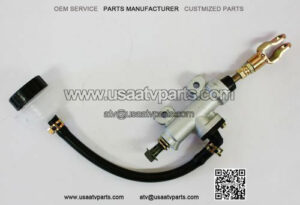The brake master cylinder is a component in your car’s braking system that drives the pressure generated by the brake pedal to the braking mechanism at your vehicles’ wheels. It’s essentially the heart of your car’s brake system.
When you press down on the brake pedal, that force pushes a piston through the brake cylinder, converting the force into hydraulic pressure.
This pressure pumps hydraulic fluid through the brake lines, transmitting pressure to a secondary cylinder at each wheel’s braking mechanism.
The secondary cylinders drive the caliper piston to engage the brake calipers in disc brakes (the wheel cylinder in drum brakes). This action then goes on to stop the wheel.
The clutch system in manual cars also employs master cylinders, but they’re not the same kind as brake master cylinders.
Where Is The Master Cylinder Found?
For manual brakes, the master cylinder is attached directly to the firewall and linked to the brake pedal.
In power-assisted brakes, the master cylinder is attached to a brake booster, which supplies more power to the braking system. The assembly is attached to the firewall in the engine compartment, with the brake pedal linked to the booster.
Now that you know how the master cylinder functions in the brake system, let’s see what happens inside the master cylinder:
How Do Master Cylinders Work?
Most master cylinders have a “tandem” design (sometimes called a dual master cylinder).
In the tandem master cylinder, two master cylinders are combined inside a single housing, sharing a common cylinder bore. This allows the cylinder assembly to control two separate hydraulic circuits.
Each of these circuits controls the brakes for a pair of wheels.
The circuit configuration can be:
- Front/rear (two front and two rear)
- Diagonal (left-front/right-rear and right-front/left-rear)
This way, if one brake circuit fails, the other circuit (that controls the other pair) can stop the vehicle.
There’s also a proportioning valve in most vehicles, connecting the master cylinder to the rest of the brake system. It controls the pressure distribution between the front and rear brake for balanced, reliable braking performance.
The master cylinder reservoir is located on top of the master cylinder. It must be adequately filled with brake fluid to prevent air from entering the brake system.
Here’s what happens in the master cylinder when you press down on the brake pedal:
- A pushrod drives the primary piston to compress the brake fluid in its circuit
- As the primary piston moves, hydraulic pressure builds inside the cylinder and brake lines
- This pressure drives the secondary piston to compress the brake fluid in its circuit
- Brake fluid moves through the brake lines, engaging the braking mechanism
About Master Cylinder
“master cylinder”
“master cylinder brake”
“master cylinder clutch”
“master cylinder replacement”
“master cylinder symptoms”


